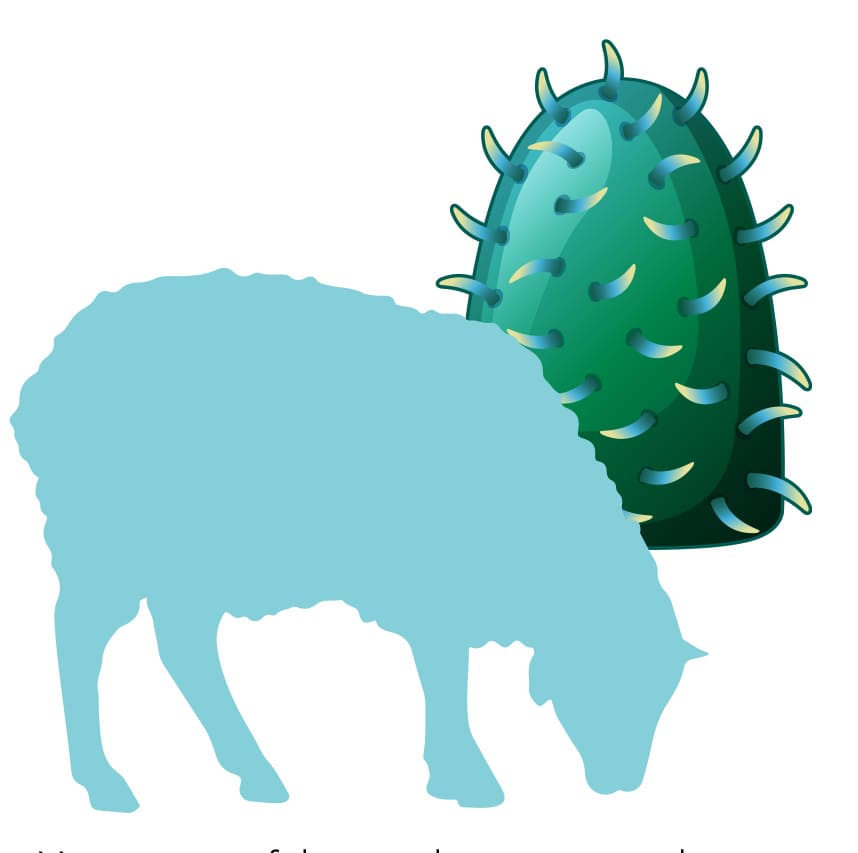

This is Wolboer/Wool Farmer’s veterinary Q&A column, sponsored by Afrivet. Send your questions about animal diseases, biosecurity, and animal health management to
Hierdie is Wolboer/Wool Farmer se veeartsenykundige vraag- en-antwoord-rubriek waarvoor Afrivet sy kundigheid verskaf. As jy vrae het oor dieresiektes en -gesondheid, stuur dit na

QUESTION:
Can sheep get rabies?

>> ANSWER:
In short, the answer is yes. Sheep can and frequently do contract the rabies virus.
We are currently facing one of the biggest outbreaks of rabies in South African history. The three provinces that are the worst affected are the Eastern Cape, KwaZulu-Natal, and Limpopo. Historically, the eastern parts of South Africa have reported the most cases, especially of dog rabies, however, people residing in the Northern Cape and Western Cape should still be aware that there could be spill-over of rabies from wildlife to their pets and livestock. There was a recent case of a rabid sheep in the Free State too.
Sheep, as mammals, are susceptible to the rabies virus. They are incidental hosts (not part of the canine or mongoose cycles) and usually dead-end hosts (not commonly transmitting viruses to other animals or species when infected). Symptoms can vary and resemble those seen in cattle. These include aggression particularly on provocation, incessant bleating, vicious attacks on inanimate objects, butting other sheep, attacking humans, separating themselves from the rest of the herd, anorexia, knuckling of fetlocks especially hind limbs, swaying gait, tail and posterior limb paralysis, jaw and tongue paralysis, profuse salivation, dragging hooves, pseudo-oestrous, hypersexual behaviour, decreased milk production, dilated pupils, fixed stare, grinding teeth, pica, tenesmus with diarrhea, frequent urination, loss of condition, and emphysema. Multiple animals can be affected, particularly when a rabid jackal or dog transmits the virus to the flock.

The most common symptoms in sheep are:
- hypersexual behaviour,
- sexual excitement,
- incessant bleating,
- aggression,
- aimless running,
- pawing and paddling, and
- grinding of teeth.
Vaccination of dogs and cats is compulsory in South Africa [Animal Diseases Act (35 of 1984)]. As a result, the government provides free vaccinations to members of the public for dogs and cats during rabies vaccination campaigns and when there are outbreaks. Sheep and other livestock are not included in the compulsory vaccination programme. However, vaccination of a herd in high-risk areas is advisable if you are farming in an area where you do see outbreaks of rabies from
time to time. The vaccine is not expensive and available in multidose vials from your veterinarian. It is important to verify that the vaccine you purchase is registered for sheep or goats (or cattle if you are vaccinating cattle too). Also, confirm that you are giving the correct dose at the correct age. This information is in the package insert of the vaccine.
If you notice any suspect behaviour in your herd, or suspect rabid dogs or wildlife, notify your state veterinarian immediately. It is important to confirm the diagnosis and provide the people involved with the correct post- exposure treatment. No person should die of rabies, the disease is completely preventable if handled timeously and correctly.
If you are exposed to the saliva of a suspect rabid animal, or if you are bitten or scratched, wash the area or wound with soap and running water for at least 10 minutes. Then seek medical attention. The clinic or hospital will provide you with post-exposure vaccinations as soon as possible (four vaccinations over two weeks) and/or rabies immunoglobulins within the wounds depending on your category of exposure. If you notice even a drop of blood, you need rabies immunoglobulins and a vaccine.
Once the results of the tested animal (they are killed, the brain removed and tested) are available, the post-exposure treatment will be either discontinued or completed. It is vital that the treatment is not delayed until the results are available, but started as soon as possible after exposure.
If you farm in a high-risk area where rabies is commonly reported, it could be advisable to have yourself and your children vaccinated against rabies beforehand (pre-exposure prophylaxis). This entails two vaccinations to start off with and then two yearly boosters.
Teach your children to tell you when they see suspicious animals or if they have encounters with animals that behaved strangely, for example a ‘tame’ mongoose. Sadly, the people dying of rabies are usually children under the age of 15. We should do everything in our ability to protect them and our communities at large.
Lastly, make sure your, and any other, dogs and cats on your farm/premises are vaccinated against rabies and that their vaccinations stay up to date. The farming communities are the most vulnerable to this disease, no matter where you farm in South Africa.
Together, we can eliminate human deaths due to rabies globally by 2030.
Wolboer/Wool Farmer | Vol 10 Nr 6 • 2022



